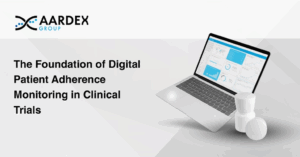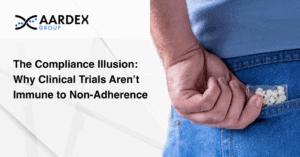Poor patient adherence tends to be a matter of people not taking their medicine as prescribed, due to access barriers. So how can placing an additional burden on patients be the answer?
As an industry, we are more than aware of the scale and consequences of non-adherence to medication, both in routine care and clinical trials.
It’s a hugely expensive problem that negatively impacts patient outcomes, leads to underestimations of product efficacy, and can drain study power to the point of trial failure.
Digital medication adherence tools have the potential to give clinicians and investigators all the information they need to identify – and respond – to risky medicine-taking patterns. But, if they are to generate reliable data, they must be frictionless for patients.
Adherence to Medication in Clinical Trials – The Elephant in the Room
There is a wall of silence around the issue of adherence in clinical trials. It has become the elephant in the room, thanks, in no small part due to a lack of workable solutions.
But the data speak for themselves. Each phase III clinical trial participant is responsible for an average of $42,000 in costs[i] yet one-third are non-adherent by day 100.[ii] Across all phases, 50% of patients admit to not following the dosing protocol.[iii]
The picture is no less staggering in routine care. According to the World Health Organization, around 50% of people with long-term conditions in the developed world do not take their medications as prescribed by their doctor. This results in worsening outcomes, additional comorbidity, and even death.[iv]
The factors that lead to poor medication adherence are complex, multifaceted, and individual, though they broadly fit into two categories: intentional and unintentional.
Intentional non-adherence is deliberate and is largely associated with patient motivation, whereas unintentional non-adherence tends to be driven by a lack of capacity or resources to take medications.
Of course, these route causes are never entirely independent of each other. Certain types of unintentional non-adherence, such as forgetting, tend to be more likely when the person’s motivation to take the medication is low, for instance. And people who unintentionally cannot afford to purchase their medicine do not take it intentionally.
Evolution of Medication Adherence Measures
It is an issue the industry has been grappling with for some time. Traditional methods, such as pill count, self-report, or even biomarker monitoring, have proved ineffective. They are open to bias and provide only a snapshot of medicine-taking behavior. Some are invasive and all place an additional burden on the patient.
In recent years, more methods relying on mobile phones, such as asking patients to fill in an e-medication diary in real-time, or record and submit a video of themselves administrating the medication, have emerged as possible solutions.
However, any solution that necessitates patients’ active involvement is deemed to fail because it is self-selecting – only those who are engaged in the protocol and with the technology will use it. But in drug development, we need initiatives that collect data from all participants.
In addition, by adding extra steps alongside an already challenging dosing regime, such approaches only serve to place more pressure on the patient – making poor adherence more, not less, likely.
Put simply, if we are to support people to take their medication, we need to be removing barriers, not putting them up. Data should be collected automatically in the background without requiring regular input from the patient.
Smart Packaging as a Segway into High-Quality, High-Density Data.
The advent of digital medication adherence tools present the pharmaceutical industry with a solid opportunity to manage adherence to medication without patients even noticing.
It’s a frictionless solution that combines smart drug packaging with powerful data analytics and visualizations, but all it asks of patients is for them to take their medicine.
Connected pre-filled syringes or smart pill bottles and blister packs, for example, can detect when the injection was administered or the tablet removed from the packet, transmit that information to a cloud-based platform.
After validated analysis of medication-taking behaviors, the platform creates visualizations and focused feedback for both study/ clinical teams and participants. Algorithms spot missed doses or erratic dosing patterns, such as medication holidays, meaning teams can risk stratify participants, and then prepare and deliver individualized interventions.
Such platforms can even be integrated with third-party applications, like patient-facing engagement building apps designed, to encourage long-term adherence.
Smart Packaging Combined with Digital Monitoring is Evidence-Based
Studies have shown that smart package monitoring is 97% accurate, compared to 60% accurate for a pill count, 50% for healthcare professional rating, and just 27% for self-report.[v]
In clinical trials, such evidence-based solutions, which can cost as little as $1 a day, provide data-driven analytics that improves adherence to medication by up to 50%[vi] and can enrich intention-to-treat (ITT) analysis.
At the same time, they help improve data quality and integrity, support evidence-based risk mitigation strategies, and ensure compliance with FDA and ICH guidelines.
What’s more, frictionless, digital medication adherence tools give drug developers insights into “real life” use, providing invaluable behavioral data for the design of successful marketing and engagement strategies.
Adherent future
Digital adherence monitoring tools work because it is a closed feedback loop. It is continuous and a frictionless method that automatically feeds information back to the study or clinical team, informing tailored action, without placing a burden on the patient.Tackling the adherence problem might finally be in our reach.
[i] Heem Wong, C., Wei Siah, K et al. Estimation of clinical trial success rates and related parameters. (2018). https://academic.oup.com/biostatistics/article/20/2/273/4817524
[ii] Fogel, D. Factors associated with clinical trials that fail and opportunities for improving the likelihood of success: A review. (2018). https://www.ncbi.nlm.nih.gov/pmc/articles/PMC6092479/
[iii] Hwang, T., Carpenter., D. et al. Failure of Investigational Drugs in Late-Stage Clinical Development and Publication of Trial Results. (2016) https://pubmed.ncbi.nlm.nih.gov/27723879/
[iv] Chisholm-Burns, M., Spivey, C. The ‘cost’ of medication nonadherence: consequences we cannot afford to accept. (2012). https://pubmed.ncbi.nlm.nih.gov/23229971/#:~:text=Consequences%20of%20nonadherence%20include%20worsening,health%20care%20costs%2C%20and%20death.
[v] Alili M, Vrijens B, et al. A scoping review of studies comparing the medication event monitoring system (MEMS) with alternative methods for measuring medication adherence. (2016). https://pubmed.ncbi.nlm.nih.gov/27005306/
[vi] Demonceau J, Rupper T, et al. Identification and assessment of adherence-enhancing interventions in studies assessing medication adherence through electronically compiled drug dosing histories: a systematic literature review and meta-analysis. (2013). https://pubmed.ncbi.nlm.nih.gov/23588595/



